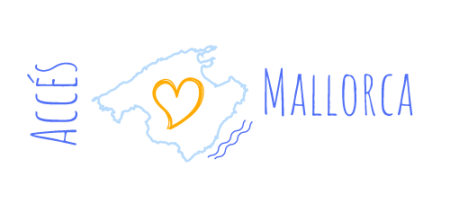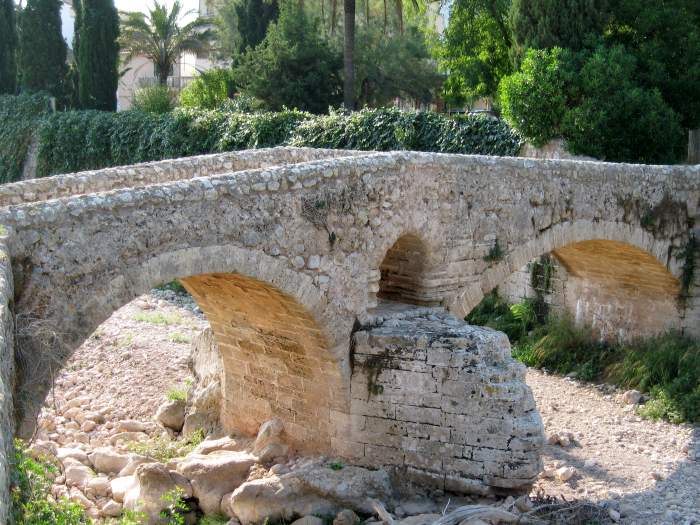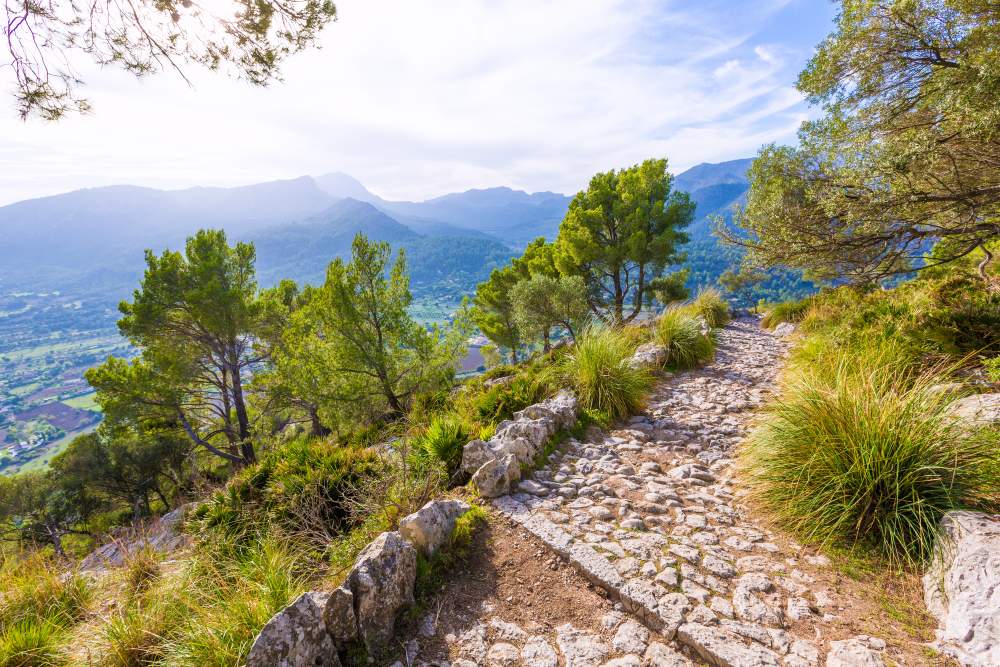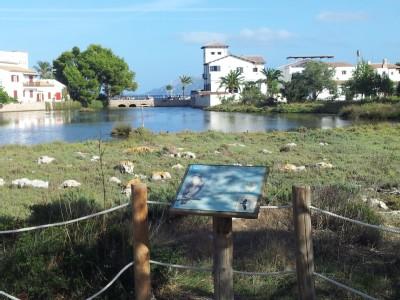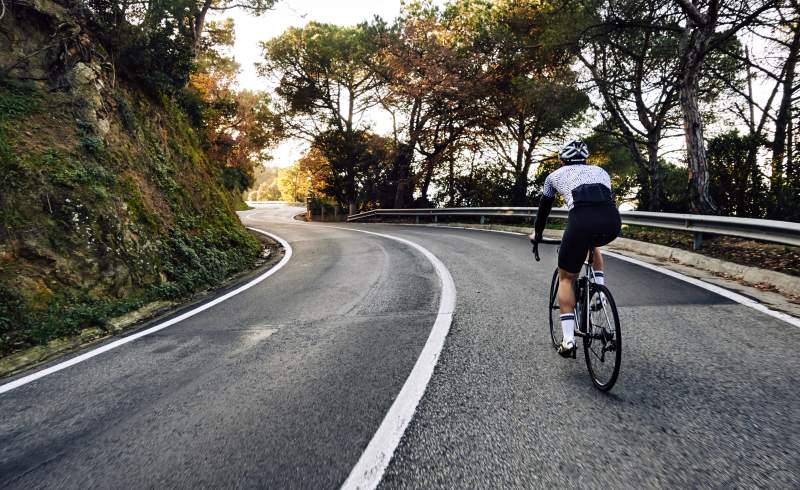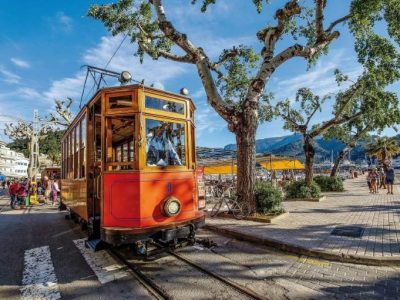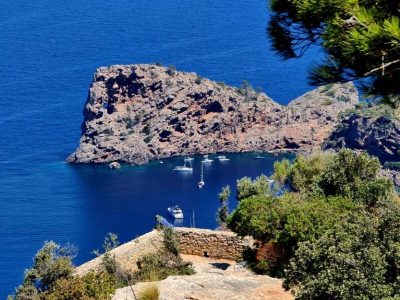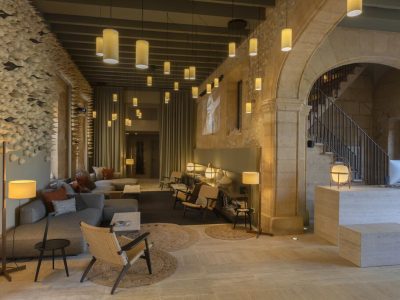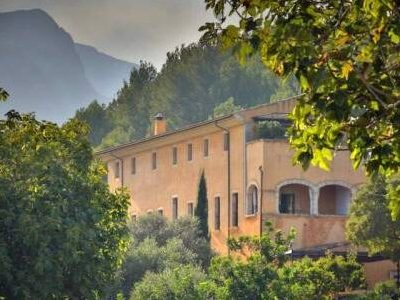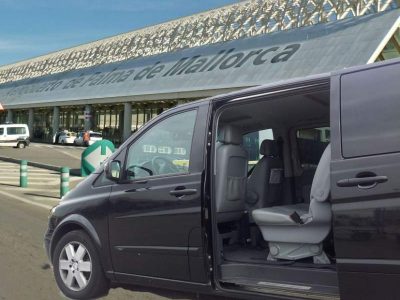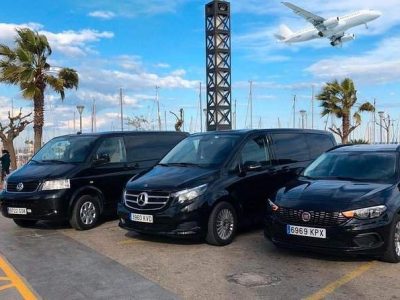All your holiday planning needs in one place, letting you book direct and benefit from official online rates
- Places To Go
- Things To Do
What’s Your Interest?
Traveling with kids
- Blog
Pollença, Mallorca - A Nerdy Guide
Pollença is a historic and charming town located on the northern cape of the Tramnuntana Mountains. In addition to the town itself, the municipality also comprise the popular holiday destinations of Port de Pollença and Cala de Sant Vicenç.
In this guide, you get to know Pollença and all it has to offer. You will find local points of interest, leisure activities, hotel, market, events and much more.
- This is where I want to go!
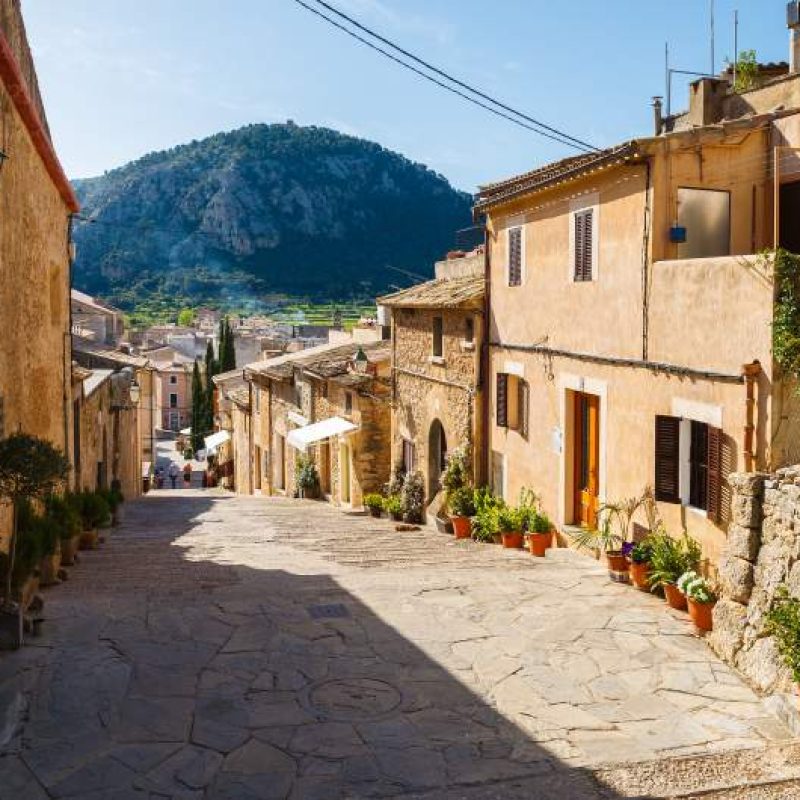
What to expect from Pollença
Pollença is quite the darling when it comes to travel destinations in Mallorca. However, most tourist only know of the beautiful coastal town of Port de Pollença, and not much about the old town hidden in a lush valley ca. 7 km (4 miles) behind the bay.
In Pollença you will find a wide range of different accommodation offers, everything from private fincas, villas and apartments to luxury hotels, agroturismos and boutique hotels, yes the possibilities are many in this area.
Best things to do in Pollença
All options are on the table in Pollença, there are almost no limitations when it comes to leisure. The area is versatile, the cultural heritage is rich and the location and infrastructure makes it easy to reach other interesting places in no time. What this means, is that when you’re looking for things to do in Pollença you can choose from a very wide selection of activities such as physical activities, sightseeing, shopping and much more.
Places of Interest in Pollença
CLIMB THE CALVARY STAIRS
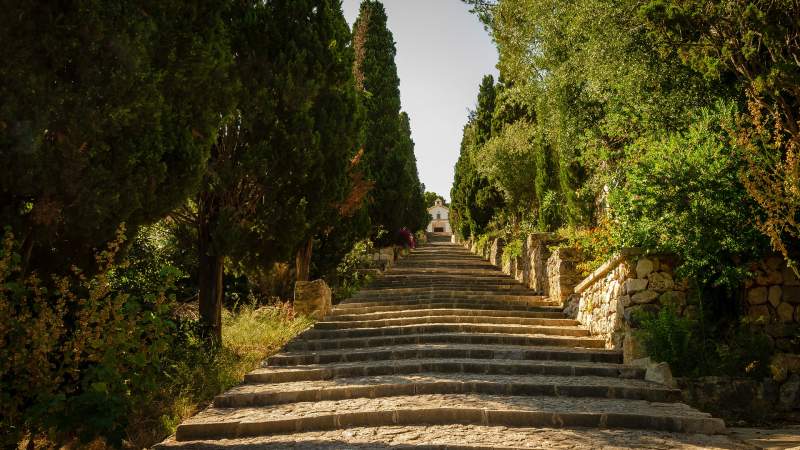
One the main attractions in Pollença, is the stairway built into the mountain slope leading to the summit. At the top of the calvary stairs, you will find the calvary chapel that is used for special occasions and religious ceremonies. However, most people would probably agree that is is the amazing views from the top that makes this climb so special and well worth the struggle. The stairway has about 400 steps, and when you reach the top you will be blessed with a feeling of accomplishment together with the breathtaking panoramic views of the entire valley.
SPEND A DAY AT THE BEACH
The bay of Pollença offers several kilometers of wonderful beach for you to enjoy. There is a range of fun activities by the beaches that you can do with or without prior experience, such as trying the paddle boards, surfing, jet skis or simply relax under the Mediterranean sun with a good book or podcast. There are two fantastic beaches; Platja de Port de Pollença and Platja d’Albercuitx, both spacious.
VISIT THE PARISH CHURCH AND MAIN SQUARE

In the heart of Pollença’s old town, you will find the massive parish church situated in the main square. The church was first built by the Knights Templar after the Catalan conquest of Mallorca, in 1229. Then, in the 15th century, the church was expanded and the watchtower was added as part of an extensive network of towers around the island that could warn against approaching enemies. Inside, you will find some beautiful treasures and art works worth seeing. If you do not want to go inside, stay outside and admire this amazing construction from one of the many bars and restaurants in the square.
MUSEU DE POLLENCA
The municipal museum of Pollenca is a great place to learn about the area and the rich cultural heritage here. At the museum, you will find interesting exhibitions and collections of artifacts, paintings and works representing different periods of time all the way back to the prehistory.
CROSS THE ROMAN BRIDGE
One of the most well-preserved remains of Roman presence on the island, is the Pont Roma (Roman bridge) situated in the western part of Pollença. The Roman army led by Quintus Caecilius Metellus, took over Mallorca in 123 BC after fighting in the Punic Wars for more than a hundred years. They established the capital of Pollen-tia (Alcúdia), and this bridge was an important part of the infrastructure leading to the city.
VISIT THE MARTÍ VICENC MUSEUM
Martí Vicenç was a famous artist and weaver from the local area of Pollença, whose innovative thinking and approach made his production of Mallorcan clothes and accessories renown all over Spain. At the museum, you can enjoy the many works of his, explore his workshop, his tools and machinery, as well as other interesting collections made by the artist and his wife.Visit the Marti Vicenc museum and see the artworks
VISIT THE GALLERY OF DIONÍS BENNÀSSAR
The house and gallery of local painter, Dionís Bennàssar is open to the public thanks to the foundation of same name. Dionís Bennàssar was known for his beautiful paintings of the Mallorcan nature that occupied him more than anything else. Here in his house, you can explore the life of this local artist, see his workshop and enjoy the many splendid works.
Visit the Dionis Benassar house museum and see the artworks of the local painter
ORATORI DE SANT JORDI
This little oratory standing on the corner of a cute square, was originally built back in the 16th century as a gathering place for soldiers to prepare for battle when the coast was under attack of pirates.
WALK TO THE MOUNTAINTOP SANCTUARY OF PUIG DE MARIA
If you just can’t get enough of walking/hiking, climb to the summit of the Maria mountain found in the Pollença valley. At the top, you can rest at the old convent of Maria while enjoying the breathtaking views of the bays of Pollença and Alcúdia, as well as the Tramuntana mountains to your west. The sanctuary was built back in the 14th century, as it was commonly believed that the higher you went, the better you would be protected from the plague.
VISIT THE SANTUARI DE LLUC MONASTERY AND CHOIR SCHOOL
The Lluc monastery is a religious hub of Mallorca, a mandatory destination for pilgrims and, home to one of Europe’s oldest and most recognized choir schools. At the monastery, you’ll also find an interesting ethnological museum that will guide you through the history of Mallorca. Even if you’re not normally interested in religious sites, the Lluc sanctuary is quite an impressive sight that most tourists enjoy.
FORTRESS OF CASTELL DEL REI
Castell del Rei (King’s Castle) is an old fortress built by the Moors and later used by the Catalan conquerors of the island. Castell del Rei is a very popular place of interest amongst walkers, because the excursion offers so many amazing and unforgettable views while you make your way through the unspoiled and merciless landscapes of the Tramuntana mountains. When you arrive at Castell del Rei, you will be blessed with the most divine views while exploring this historical place.
WALK TO THE OLD LOOKOUT, TALAIA D’ALBERCUTX
If you are up for walking or hiking in the beautiful nature, you’re in luck when visiting the area of Pollença. On the mountain sides, you will find the old medieval watchtower of Albercutx from where you can enjoy a refreshment while taking in the breathtaking panoramic views of the bay of Pollença and Formentor.
ENJOY THE BREATHTAKING VIEWS FROM THE VICTORIA HERMITAGE
On the opposite side of the Pollença bay, another peninsula stretches from Mallorca’s north coast, namely the Alcanada peninsula. Up here, you’ll find the old hermitage of Victoria, a sacred place that has now been transformed to a hostel and cafeteria. From the old hermitage, you can enjoy the magical views of the bay of Pollença and see to the bay of Formentor.
GO BIRDWATCHING IN THE LA GOLA RESERVE
La Gola is a small and very charming wetland found in Port of Pollença. In the La Gola reserve, you can spot species such as blackwinged stilt, cetti’s warbler, the greenfinch, cattle egret, mallard, wood pigeon and various species of herons. This small piece of paradise is the perfect escape from the mass tourism that occupies most of the area.
GOLFING IN BEAUTIFUL SETTINGS
Pollença is home to a nice 9-hole golf course situated in the green valley with the mountains rising around it. If you want more, make the short drive to nearby Alcúdia and find the Alcanada golf course, a beautiful 18-hole course overlooking the bay of Port d’Alcúdia and the iconic Alcanada lighthouse island.
RENT A BIKE AND GO ROAD CYCLING
Road cycling is undoubtedly one of the most popular sports and things to do in Mallorca. The extensive network of paved roads, the many hairpin turns in the mountains and the stunning surroundings make road cycling a joy for all levels. There is a great selection of bike rentals in Pollença, where you can find a variety of different types of bikes and have them customized to match your physique.
MOUNTAIN BIKING IN THE TRAMUNTANA
If you prefer gravel over asphalt and want to get closer to nature while spinning, then a mountain bike trip is a perfect idea. There are numerous trails you can explore in the Tramuntana, all of them will get you to some of the most magical places and vantage points and the best thing is, there is almost no traffic to pay attention to. Head down to the nearest bike rental shop in the town and have them set up a mountain bike for you, or join a MTB guided tour.
FAQ
Pollença is a popular destination all year round thanks to its location close to mountains and coast. Winter and spring is perfect for sports and physical activities, while the warm Mediterranean summer invites to the fantastic beaches.
Pollença is an area abundant in places of interest and beautiful spots. Most famous is Pollença for its coastal area of Port de Pollença, the stairway of El Calvario leading to a hilltop chapel, and the mountaintop sanctuary of Puig de Maria.
You will find the weekly market in Pollença on Sundays at the main square of the old town.
On Wednesdays, there’s a market in Port de Pollença.
Head out to Port de Pollença where you’ll find two spacious sandy beaches that together comprise about 3 km of beachline. North of the marina, you’ll find the Platja d’Albercutx, and south of the marina, the Platja de Port de Pollença.
Both beaches are excellent for various activities such as swimming, paragliding, sailing etc.
Yes, Pollença is very safe to visit. However, you should always keep your personal items safe anywhere you travel.
Events in Pollença
Pollença weekly market
The weekly market in Pollença old town is held on Sundays, in the main square by the parish church.
The weekly market in Port de Pollença is held on Wednesdays.
January
Sant Antoni (Saint Anthony)
The celebration of Sant Antoni is the most traditional in Mallorca, it was introduced already in the late Middle Ages. Sant Antoni is patron saint of domestic animals, and every year blessings of pets takes place in the town. The celebration is characterized by the many bonfires lit in the streets, as well as the famous pine climbing contest Saturday evening. Participants compete in climbing a pine tree of 20 meters that has been soaped in, a custom of Pollenca.
When: January 16th and 17th
Where: Old town
Sant Sebastià (Saint Sebastian)
The celebration of Saint Sebastian is almost as traditional as the celebration of Saint Anthony. In Pollença, you can look forward to the dance of two young men and their cardboard horses, who dance to the rhythms of a drum and tambourine while a flag symbolizing the saint is waved.
When: January 20th
Where: Old town
April
Setmana Santa (holy week)
Easter is always a special time to be in Mallorca, as there are numerous events and celebrations in all villages. Pollença is one of those places most interesting during Easter, as a great procession of Christ takes place on the 365-step Calvary stairway, an event that has been a great tourist attraction since the 1960’s. The procession starts at the summit of the Calvary stairs by the chapel of same name, and follows a route marked by paintings of the Passion of Christ, until it reaches the parish church of Our Lady of Angels.
When: Easter
Where: Old town
Fira del Vi (wine fair)
Since 2004, the annual wine fair has been held in the Sant Domingo convent in Pollença’s old town. A wide range of Balearic wineries are represented at the fair which usually attracts a large audience of tourists and locals coming to taste the many different wines and learn about Balearic oenenology.
When: April
Where: Convent of Sant Domingo
June
Corpus Cristi
The Corpus Cristi festivity is a tradition held since the 1600’s. The main highlight of this celebration, which has often been associated with the weavers guild, is the procession where Sant Joan Pelós (John the Baptist) followed by two eagles dances through the old town carrying a lamb. The music that accompanies the characters dates back from medieval times, and the costumes of the two eagles are very beautifully decorated in jewels.
When: June
Where: Old town
Festes de Sant Pere (celebration of Saint Peter)
Former patron saint of Port de Pollença, Saint Peter, is celebrated in the days around June 29th with a series of cultural activities and happenings. The celebration occurred for the first time back in the early 20th century when the urban development of Port de Pollença started to take shape.
During these days, you can look forward to exhibitions, concerts by traditional Mallorcan bagpipes and dances.
When: The days leading up to June 29th
Where: Port de Pollença
July
Festes de la Mare de Deú del Carme (celebration of the Virgin of Mount Carmel)
Present day patron saint of fishermen, Virgin of Mount Carmel, is celebrated on July 16th. On this day you can enjoy a wide range of cultural events, such as traditional dances, concerts and speeches. Moreover, there are boat trips in the bay of Pollença.
When: 16th of July
Where: Port de Pollença
August
La Patrona
August starts out with the celebration of Our Lady of Angels, patron saint of Pollença. According to tradition, the day begins with the performance of a musical piece known as the “Alborada” composed by Nicolás de Castro played at 5am in the morning. The festivities are officially inaugurated with a speech in the cloister of the Sant Domingo convent, a tradition practiced since 1970.
The main event and highlight of this festival, is the reenactment of a legendary clash between Ottoman forces and local troops from Pollença that happened in the early morning hours on May 31st, 1550. The Ottoman forces were commanded by Dragut while the local troops by Joan Mas, a battle which ended with Mallorcan victory. The first evidence of this reenactment dates from 1860.
The acts begins with a meeting between Joan Mas and Dragut at Plaça de l’Almoina, by the peacock fountain. The events has three stages, each with lively and realistic clashes through town. At the final stage, usually by the soccer field of Ca’n Escarrinxo, the Christian troops frees the hostages taken by the Ottomans and march back to the old town. In front of the parish church, at the main square, the victorious troops sings a famous “Te Deúm” composed by Reverend Miquel Tortell. Inside the church, the “Puig Patrona” is sung, a poem by local artist Costa i Llobera.
When: 2nd of August
Where: Pollença
Festival de Pollença
The Pollença festival is for you who love classical music! The Festival de Pollença was founded in 1962 at the initiative of the distinguished English violinist Philip Newman. The festival has kept going and growing in popularity until today under the artistic direction of major figures such as Eugen Prokop, baritone Joan Pons and the composer Joan Valent.
Traditionally, it has been held during summer nights, in the incomparable setting of the old cloister of Sant Domingo convent, with an exquisite and demanding program that aims to bring the different artistic strands of classical music to the public.
When: Mid-August
Where: Convent of Sant Domingo
Festes de la Cala de Sant Vicenç
Ever since 1984, when the village of Cala Sant Vicenç started to transform from a small fishing community to a holiday destination, the summer festival has been held. You can look forward to a few days of fun and cultural activities such as concerts, contests, games and other performances.
When: Mid-August
Where: Cala Sant Vicenç
November
La Fira
The annual trade fair of Pollença is one of the greatest and most traditional of its kind in these areas. The fair has its roots back in 1784, and commemorates traditional agriculture and craftsmanship with a wide range of cultural activities and events. There will of course also be a great market with all kinds of local products available. Another highlight of the fair, is the craftsmanship show held in the cloister of the Sant Domingo convent.
When: Fourth Sunday after Saint Luke’s
Where: Old town
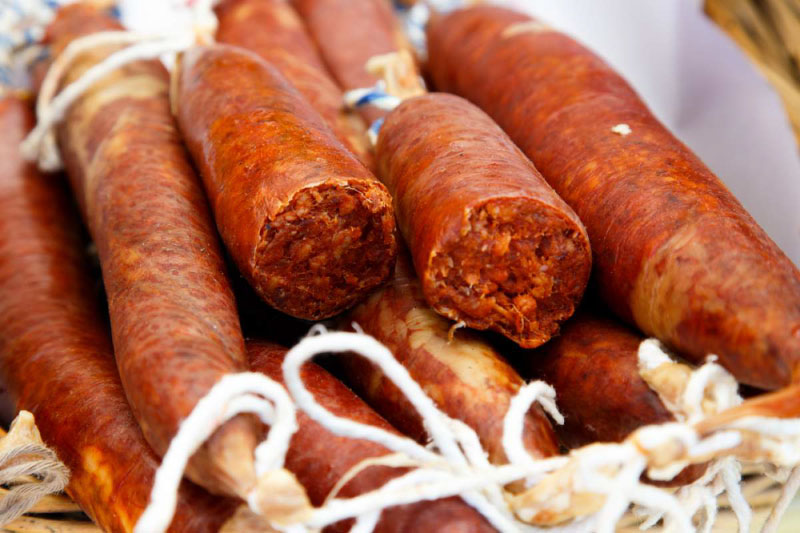
Support Local
Supporting local communities during your travels can have a profound impact. Stock up with groceries locally, stop in an artisan shop or enjoy a refreshment at a restaurant or bar. Now more than ever, these small businesses need support from travelers near and far.
The History of Pollença
Pollença is situated about 8 km inland from the more well-known holiday destination Port de Pollença, loved by many summer holidaymakers. The municipality of Pollença cover a surface of 15,114.53 hectares, whereof 12.338.69 hectares are classified as protected areas.
The total population of the municipality is 16,283 (2019 numbers), divided in the following population centers.
- Pollença
- Port de Pollença
- Cala Sant Vicenç
- Aeròdrom Militar
- Can Singala
- Bellresguard
- La Font
- El Vilar
History of Pollença
Prehistoric and Talayotic period
The history of human occupation dates back from the Bronze Ages, more specifically, around 2,000 – 1,500 BC. On the islands of Mallorca and Menorca, this period is known as the “pre-Talayotic”, as it was the period prior to the Talayotic culture which was unique to these islands. The pre-Talayotic period was characterized by the usage of caves for habitation and funerary purposes. In the later pre-Talayotic period, constructions of the so-called “navetiforms” appeared, houses built from a ground plan that reminds us of the shape of a vessel. Some of the most remarkable discoveries in the municipality of Pollença, are the constructions of Cornavaques, Bóquer, Formentor and Can Martorellet, as well as also the twelve burial caves found in Sant Vicenç.
From around 1100 BC, the Talayotic culture arrived in Menorca and Mallorca. This culture was characterized by these watchtower-like construction known as talayots/talaiots, a name they have gotten from the Catalan word talaia which means watchtower. The talayots testify to the beginning colonization from the east, namely ancient Greeks and Phoenicians, who traveled across the Mediterranean to find metals and establish trading routes.
We know, that in the middle of the 1st millennium BC, Phoenicians from Carthage, known for their trading activities, crossed the Mediterranean in their quest for ore and metals. They colonized many areas of present day southwest Spain and Portugal, known as the Iberian Pyrite Belt. They set up factories producing shoes and cloths which they could trade. We also know about the Phoenicians that they had a predilection for islands and territories close to the sea, which again testify to their trading activities.
The mixing of indigenous peoples and colonizers gave birth to not only new kinds of agricultural and industrial communities, but also a new a philosophy far more military-oriented than prior in the Bronze Age. One of the most remarkable outcomes of this mix, was the Balearic foners, deadly warriors renown and feared for their slinging abilities of accuracy and power. Actually, Hannibal the Great was cited for ordering extra protection for the foners in the wars in Italy.
The military oriented mentality also led to urban zones enclosed by megalithic walls. One of the largest Talayotic towns in Mallorca, was actually located here in Pollença, not far from the natural area and hill of Santueri. The Can Daniel Gran was discovered in the early 20th century by L. C. Watelin, who drew out the planimetry and outline of the site. Can Daniel Gran has not been properly excavated like many other Talayotic settlements in Mallorca, due to the consumption of the forest and the destruction of humans as it was used as a quarry. But the size (15,300 m2) and location Can Daniel Gran indicates a high importance similar to the site of Ses Paîsses in Artà.
From the late Talayotic period, around 300 BC, some wooden coffins shaped as bulls has been found in the lands of Can Tirana. These are, along with many other interesting artifacts and relics, exhibited at the municipal museum of Pollença.
Roman conquest
In 123 BC, about 20 years after the fall of Carthage, Roman general Quintus Caecilius Metellus conquered the Balearic islands, a conquest that gave him the title of consul and the nickname “Balearicus”. Metellus was an experienced man of war, however, he did not have many major accomplishments on his record which is part of the reason that the conquest of the Balearic Islands came in a convenient time. The official reason for the conquest, was a strike against piracy in the Mediterranean, which truly was a part of it. But more importantly, it was strategic trading outpost, that gave the Romans more dominance in the region, and again, a safer journey when they traveled by naval routes.
Quintus Caecilius Metellus was well aware of his opponents and their capabilities to defend themselves from the shores. He had already been acquainted with the Balearic foners and knew these would cause him great loses. To counter the devastating shots of the foners, he strapped leather around his ships to function as a protective shield when the projectiles hit. This tactic allowed him to embark his troops close to the shoreline.
From then, the battle began against the indigenous people of Mallorca, who retrenched and barricaded themselves in the walled enclosures of Can Daniel Gran. It was a prolonged process of finding and fighting the tribes, however, when first found the resistance was not a match for the organized and skilled Roman troops.
The Romans too mixed with the Talayotic peoples, which gave them ability to incorporate the Balearic foners in the Roman army. Actually, the foners are mentioned by Caesar in the Gaul war.
The Romans took over many of the Talayotic villages on the island, but more interestingly, they created the cities of Palma and Pol-lentia, the latter served as the capital. Pol-lentia was built just outside present day Alcúdia, where the main activities would happen, such as the forum, the amphitheater and palaces would be at. However, Can Daniel Gran coexisted with the capital of Pol-lentia (meaning power). The Romans also constructed the bridge that crossed the river, Torrent de la Vall d’en Marc, at that time much wider, which testify to the enormous area they operated in.
Moorish occupation
In 902, Moorish general Iṣām al-Ḫawlānī conquered the Balearic archipelago and incorporated it into the Emirate of Cordoba. Later in 1015, it became a part of the Taifa de Dénia.
During the Moorish occupation (902-1231), Mallorca was divided in roughly twelve jurisdictions in order to easier administrate it and collect taxes to build Madina Mayurqua (Palma), which became the capital. Pollença and Alcúdia became one district named Bullensa, a name they took from Pol-lentia and translated to Arabic.
The Moors were agrarian people living in farms and huts scattered all over the area in so-called alquerias and rafals, in kindred clans or tribes. There were only about 5-6 population centers at that time including Madina Mayurqua, some others were in Artà and Felanitx.
One of the most populated areas around Pollença was at the present day Son Grua from where artifacts of a funeral ceremony has been discovered with Arabic inscriptions dating from 1123. It is also from these finds that we become aware of the name of the clan that was probably the first inhabitants of Pollença; Zaynab.
The Catalan conquest
In the years between 1229 and 1231, King Jaume I of Aragón conquered Mallorca. Madina Mayurqua fell after just three month of siege. Following the conquest, King Jaume divided and distributed the lands of the island amongst knights, orders, barons and church, documented in the Llibre del Repartiment de Mallorca (Book of Distribution of Mallorca). This was when the kingdom of Mallorca was born, a kingdom that would last until 1349.
Bullensa was divided among the king himself and the Knights Templar, who was given the area of present day Pollença and some land near the hill of Sant Martí in Alcúdia. There was also some lands given to the order of Dertusa (Tortosa), the bishop of Mallorca and some barons. However, not many years later, the Templars gained dominance over almost all of the area allowing them to prosper greatly from renting out lands, as well as jurisdiction. In 1240, the Templars also gained religious dominance as the bishop of Mallorca, Ramon de Torrella, was ceded from the parish. At the top of the Puig del Temple, present day Calvario, a chapel was erected as symbol.
Pollença quickly grew in popularity and the population increased, actually, Pope Innocent IV recognized the first church or chapel in a bull from 1248. But towards the end of the century, despite that Pollença was one of the most important town outside Palma, a lot of confrontations and disputes with the Templars started to occur, they had too much influence and did not respect the wishes of King Jaume.
In 1314, the Templars were replaced by the Knights Hospitaller as lords of Pollença. By then, Pollença had already a population of 3,000 inhabitants and prospering from agricultural activities, namely sheeps. However, as the Black Death ravaged Europe in 1348, the population and economical activities fell drastically. The plague reached the island due to rats onboard ships that came to Port d’Alcúdia. In that year, the sanctuary of Puig de Maria was constructed. At that time, it was commonly believed that the higher you could go the safer you would be. The sanctuary was expanded in 1370.
The end of the Mallorcan kingdom
In 1343, Jaume III of Mallorca was found guilty in plagiary by the courts of Barcelona. He had been printing Barcelonian currency in Perpignan, present day France. He was sentenced to transfer all of his assets and properties to Peter the Ceremonious, king of Aragón.
In May the same year, Peter “invaded” Mallorca in compliance with the sentence and defeated Jaume whom fled to Roussillon and Sardinia. Pollença was one of the towns that defended Jaume and the kingdom of Mallorca against the troops from Aragón.
Another military campaign in 1344 set Jaume further back, as Peter’s troops took control Roussillon, Menorca and Eivissa (Ibiza), still in compliance with the sentence of 1343, In July 1344, Jaume surrendered to Peter on the condition that his life was spared and he was given his freedom, as well as keeping Montpellier as the last state in his possession. Jaume then took refuge in the papal court in Avignon.
However, Jaume was not done, he was determined to win back Mallorca at any cost. For this purpose, he sold Montpellier to the king of France for 120,000 gold coins with the blessings of Pope Climent VI.
With his first payment for Montpellier, Jaume assembled an army of mercenaries and set sails for Mallorca in the fall 1349. On October 11, he disembarked his troops at the beach of Cap de Formentor and on the beach of Albercutx in the bay of Pollença, a total of 300 horsemen and 700 infantry. Jaume met resistance in Pollença, that held stand for two whole days before he broke through an besieged the town. Jaume’s hope was initially, that the people who had fought Peter’s troops in the battles of Castell del Rei, in 1343, would support him, but they had turned their backs on him which led to several brutal battles in the area. Following the defeat of Pollença, Jaume and his troops invaded Alcúdia and later Muro, both towns suffered great destruction of both buildings and fields.
On October 25th, Jaume lost the kingdom of Mallorca in the Battle of Llucmajor against Peter’s troops.
The revolt of the artisans guilds
In the beginning of the modern age, Mallorca faced two major civil wars; Revolta Forana and Revolta de les Germanies, both had roots in high fiscal pressure and corruption.
At that time, when talking about areas of Mallorca, there was the Ciutat de Mallorca (Palma) and the Part Forana (foreign part), which was basically all districts outside the capital. Many lands of the foreign parts of Mallorca were owned by the nobility of the Ciutat de Mallorca, who rented out soil for peasants.There was of course also many small landowners who employed day laborers.
A series of droughts and plagues had major consequences for the peasants who had trouble cultivating crops to sell, but at the same time, the fiscal pressure was intensified, but only for the peasants and not the nobility. In 1450, the king commanded a document conducted which would declare all landowners of the island. As many peasants and smaller landowners did not have paper on their rights to administrate their lands, their properties went to the nobility, which caused the first societal conflict and civil war. This conflict ended with the king sending mercenaries to the island to end the conflict in 1453.
About 70 years later, in 1520, a new conflict arose, the revolt of the Brotherhood. This time it was the artisans guilds that was trying to create a twin society in order to remove the public debt and end corruption of the nobility. This movement happened many places in Spain and particularly in Barcelona and Valencia. Joanet Colom, a local artisan of Felanitx, was the main agitator of the Brotherhood in Mallorca.
As the requirements of the Brotherhood were denied by the governor, things soon turned violent several places on the island. The Brotherhood gained support from multiple towns which were besieged and under control of the movement. From November 1521, the Brotherhood tried multiple times to break the fortified walls of neighboring town of Alcúdia, where most of the island’s nobility had taken refuge.
In October 1522, the imperial troops sent by King Carles arrived at the port of Alcúdia, from where the most brutal military campaign since the conquest in 1229 began.
Pollença, which was predominantly on the side of the Brotherhood and had participated in numerous attacks on Alcúdia, was one of the first towns to feel the wrath of the imperial forces. On October 29th, the troops reached and seized the town, which was completely sacked with no exemptions. The parish church of Santa Maria at the main square quickly became a refuge for the inhabitants who tried to escape the soldiers, and waited in hope that it would be possible to negotiate a peaceful surrender. However, the imperial troops were not prepared to wait for a surrender.
The troops lit the doorways of the church on fire, and the about 200 people locked inside the church died from asphyxiation, mostly women and children. Men were slaughtered in the main square, many was hung from the trees and other’ body parts were nailed to the trees along the roads to set an example. Those people that was not killed during the siege fled to the mountains.
The Brotherhood sent reinforcements, who met the imperial army in the marshes of Sa Pobla in November where they too were slaughtered. This was the end of the revolt.
As a consequence, all towns and families that had taken part in the revolt was penalized with massive fines, including Pollença.
The war of the Brotherhood, the plague of 1523, the repressions and immigration caused a reduction of a third of the Mallorcan population. The towns of Sencelles, Binissalem, Felanitx, Pollença, Alcúdia, Bunyola, Santanyí and Llucmajor lost more than half of their inhabitants.
A new parish church was erected in the 1570’s, which again was replaced by the current Baroque temple built in the 18th century under the invocation of Our Lady of Angels.
The Ottoman threat
If things weren’t bad enough after the war of the Brotherhood and various natural disasters, the Ottoman empire started attacking the Balearic archipelago in the middle of the 16th century. The brutal sacking of Mahón in Menorca, in 1558, where more than 6,000 people were taken as slaves, was a clear warning that a new threat was close. The Ottoman navy allied with corsairs from North Africa making it possible to attack Mallorca from all coasts.
On May 31, 1560, an attack on Pollença was a reality. The raid was planned and executed by legendary naval commander Dragut, but was rejected and chased off by captain Joan Mas and his brave troops.
The 16th and 17th century were marked by a constant threat from pirates approaching the bays of Mallorca. Many towns was subject to brutal raids of looting and destruction where especially women and children were taken hostage for enormous ransoms.
The arrival of religious communities
In the beginning of the 17th century the threat of the pirate attacks had gradually decreased and the population started to grow once again and reached about 4,000 inhabitants. The area became dedicated to agriculture and textile work, which would become one of the industries that made Pollença stand out among other towns. The growth of the population and economy also attracted the Dominican monks who arrived in 1578 and constructed the great Sant Domingo convent, finished in 1588, which still retains its stunning baroque altarpiece from 1651 built by Joan Antoni Oms.
After a time of violence up through the 17th century, things calmed again towards the end of the century. As order was restored in the town, the Jesuits arrived in 1688 and started their school and began the construction of their Baroque church. The church was not completed until 1738, shortly before the expulsion of Jesuits from Spain due to their highly socio-cultural impact which did not settle well with the king.
During the same period, the new parish church of Our Lady of Angels was begun (1714-1790), although the facade was not finished until the second half of the 19th century.
Demographic changes
In the mid-19th century a new population center was born, namely Port de Pollença. At that time, the coastal area was simply known as “Moll” by the locals, and only a single family of fishermen lived here. However, this family turned fishing into a profession in 1865, which gave rise to the construction of the wharf. In the year 1900, there were already about a hundred families of fishermen living here.
By the end of the 19th century, the population reached a maximum of 9,000 inhabitants. The number fell during the great emigration to Argentina around 1888, as Mallorca, like France and Italy, was ravaged by phylloxera which caused all grapevines to be destroyed. The many landowners of Pollença moved to Argentina, particularly La Plata and Rosario, to find new adventures and fortunes.
The development of new urban areas and economical activities also introduced great cultural influx with the appearance of prominent figures such as the Catalan-language poet Miquel Costa i Llobera (1854-1922), the historian Mateu Rotger (1862-1916), educator and republican Guillem Cifre de Colonya (1852-1908), founder of the Institution of Education of Pollença.
The cultural impact of the area continued to bloom during the first decades of the 20th century, when artists such as Anglada Camarasa, Atilio Boveri, Titto Citadini and Roberto Ramaugé among others came to the picturesque Port de Pollença, which reached a population well above 500 inhabitants in 1930. It was during this period that tourism was born in Pollença, several decades before tourism arrived in Mallorca for real. Some of the first hotels of Port de Pollença, were the Bellavista, Illa d’Or, Miramar, Marina Bristol and Mar i Cel. It is also worth mentioning the opening of the first Mallorcan luxury hotel, the Hotel Formentor, in 1928. In Pollença’s old town, the Cal Lloro abd Cosmospolita were the pioneers, and in Cala Sant Vicenç, which was still a fishing community, the Nui pension opened.
However, easy come easy go, and with the outbreak of the Spanish Civil War in 1936, tourism and social progress broke. The town was victim of a strong repression, and several locals were imprisoned or shot.
Introduction of mass tourism
Following some rough times of repression and lack of employment after the Civil War, the economy saw an uprising in the 1950’s and 60’s as mass tourism arrived on the island. The economic recovery resulted in a great re-population of the area, as hands were needed to accommodate the new requirements of the tourism industry, many was immigrants from Andalusia. In 1968, the population of Pollença reached about 10,000 inhabitants for the first time in history.
Port de Pollença too experienced a great increase of the population as a result of the tourism. The area ceased as an active fishing harbor and turned into a modern growing town. In 1981, there was already about 3,000 residents. Most of the traditional industries disappeared during the 1960’s, with exception of a few which became quite important to the local economy; the Can Morató carpet factory, the Can Siquir shoe factory, the Beba Salut soft drink factory and the Cuixac tile factory. However, in the 70’s and 80’s these industries were too curtailed. One important an emblematic industry that sustained, however, was the the llengües weaving industry, a special technique and art mostly famous by the works of local artist Martí Vicenc (1926-1995).
During the 1980’s, Cala de Sant Vicenç developed significantly, as well as population centers such as La Font, El Vilar, Gotmar and Llenaira.
Today, Pollença is more or less completely dedicated to tourism. But the mix of many different cultures of former immigrants and newcomers has created a multi-cultural atmosphere with a vibrant consumer life and a very particular charm that no other place can perform.
Practical Info
Useful Numbers
Emergency: 112
National police: 091
Local police: 092
Guarda civil: 062
Fire: 080
Maritime emergencies: 900 202 202
Tourist Office: + 34 971 535 077
Public Transport
Bus lines: 340, 345
Power Supply
220V
